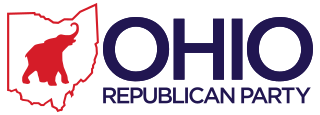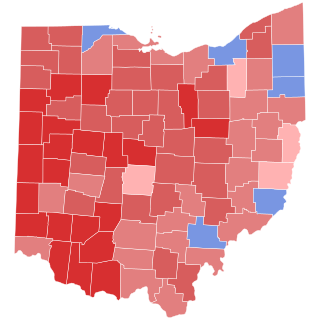
A political family is a family in which multiple members are involved in politics — particularly electoral politics. Members may be related by blood or marriage; often several generations or multiple siblings may be involved.

Robert Alphonso Taft III is an American politician and attorney who served as the 67th governor of Ohio from 1999 to 2007. A member of the Taft political dynasty and Republican Party, Taft previously served in the Ohio House of Representatives, then as Hamilton County commissioner, and as Ohio Secretary of State under governor George Voinovich.

Lee Irwin Fisher is an American attorney, politician, and academic. A member of the Democratic Party, he served as the 64th lieutenant governor of Ohio, with Governor Ted Strickland, from 2007 until 2011. He has served as Dean of Cleveland State University College of Law since 2017.

Stephen Marvin Young was an American politician from the U.S. state of Ohio. A member of the Democratic Party, he served as a United States senator from Ohio from 1959 until 1971.

The Ohio Republican Party is the Ohio affiliate of the Republican Party. It was founded in Columbus, Ohio, in 1854.

The 1978 United States Senate elections were held on November 7, in the middle of Democratic President Jimmy Carter's term. The 33 seats of Class 2 were contested in regular elections. Special elections were also held to fill vacancies.

The 1970 United States Senate elections was an election for the United States Senate. It took place on November 3, with the 33 seats of Class 1 contested in regular elections. Special elections were also held to fill vacancies. These races occurred in the middle of Richard Nixon's first term as president. The Democrats lost a net of three seats, while the Republicans and the Conservative Party of New York picked up one net seat each, and former Democrat Harry F. Byrd Jr. was re-elected as an independent.

The 1964 United States Senate elections were held on November 3. The 33 seats of Class 1 were contested in regular elections. Special elections were also held to fill vacancies. They coincided with the election of President Lyndon B. Johnson by an overwhelming majority, to a full term. His Democratic Party picked up a net two seats from the Republicans. As of 2023, this was the last time either party has had a two-thirds majority in the Senate, which allowed the Senate Democrats to override a veto, propose constitutional amendments, or convict and expel certain officials without any votes from Senate Republicans. However, internal divisions would have prevented the Democrats from having done so. The Senate election cycle coincided with Democratic gains in the House in the same year.

Bruce Edward Johnson is an American lawyer and Republican politician who was appointed the State of Ohio's 63rd lieutenant governor on January 5, 2005, to complete an unexpired term. Johnson concurrently served as Director of the Ohio Department of Development.

United States gubernatorial elections were held on November 7, 2006, in 36 states and two territories. The elections coincided with the midterm elections of the United States Senate and the United States House of Representatives.

The 2006 Ohio gubernatorial election was held on November 7, 2006, and was a race for the Governor and Lieutenant Governor of Ohio. Incumbent Governor Bob Taft could not run for re-election, because Ohio governors are limited to two consecutive terms in office. The election was held concurrently with a U.S. Senate election. The general election for governor pitted Ohio Secretary of State Ken Blackwell, the Republican nominee, against United States Congressman Ted Strickland of Ohio's 6th congressional district, the Democratic nominee. Their running mates were former Ohio Attorney General Lee Fisher on the Democratic ticket and State Representative Tom Raga on the Republican ticket.

United States gubernatorial elections were held on November 5, 2002, in 36 states and two territories. The Republicans won eight seats previously held by the Democrats, as well as the seat previously held by Minnesota governor Jesse Ventura, who was elected on the Reform Party ticket but had since renounced his party affiliation. The Democrats won 10 seats previously held by the Republicans, as well as the seat previously held by Maine governor Angus King, an independent. The elections were held concurrently with the other United States elections of 2002.

Elections in Vermont are authorized under Chapter II of the Vermont State Constitution, articles 43–49, which establishes elections for the state level officers, cabinet, and legislature. Articles 50–53 establish the election of county-level officers.

The 2010 United States Senate election in Ohio was held on November 2, 2010 as one of many Ohio elections in 2010. Incumbent two-term Republican U.S. Senator George Voinovich decided to retire instead of seeking a third term. Former Representative Republican Rob Portman won the open seat.

The Ohio general elections, 2010 were held on November 2, 2010 throughout Ohio. Primary elections took place on May 4, 2010.

The 2014 Massachusetts gubernatorial election took place on November 4, 2014, to elect the Governor of Massachusetts, concurrently with the election of Massachusetts' Class II U.S. Senate seat, and other elections to the United States Senate in other states and elections to the United States House of Representatives and various state and local elections.

United States gubernatorial elections were held on November 4, 2014, in 36 states and three territories, concurrent with other elections during the 2014 United States elections.

The 2014 Kansas gubernatorial election took place on November 4, 2014, to elect the Governor of Kansas, concurrently with the election of Kansas' Class II U.S. Senate seat, as well as other elections to the United States Senate in other states and elections to the United States House of Representatives and various state and local elections.

The 2020 Indiana gubernatorial election was won by incumbent Republican Eric Holcomb on November 3, 2020. The election was held concurrently with the 2020 U.S. presidential election, as well as elections to the United States House of Representatives and various state and local elections.

United States gubernatorial elections were held on November 8, 2022, in 36 states and three territories. As most governors serve four-year terms, the last regular gubernatorial elections for all but two of the seats took place in the 2018 U.S. gubernatorial elections. The gubernatorial elections took place concurrently with several other federal, state, and local elections, as part of the 2022 midterm elections.























